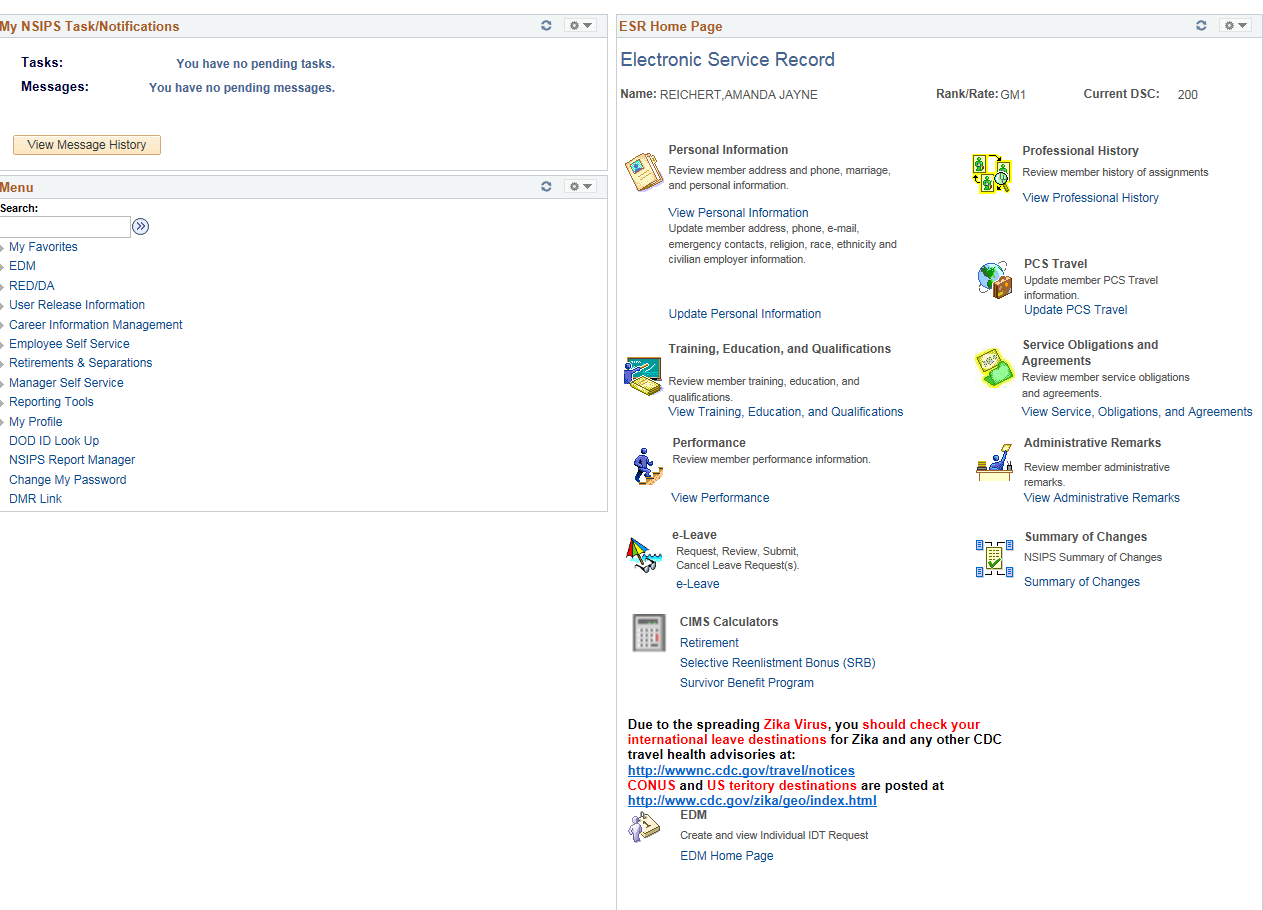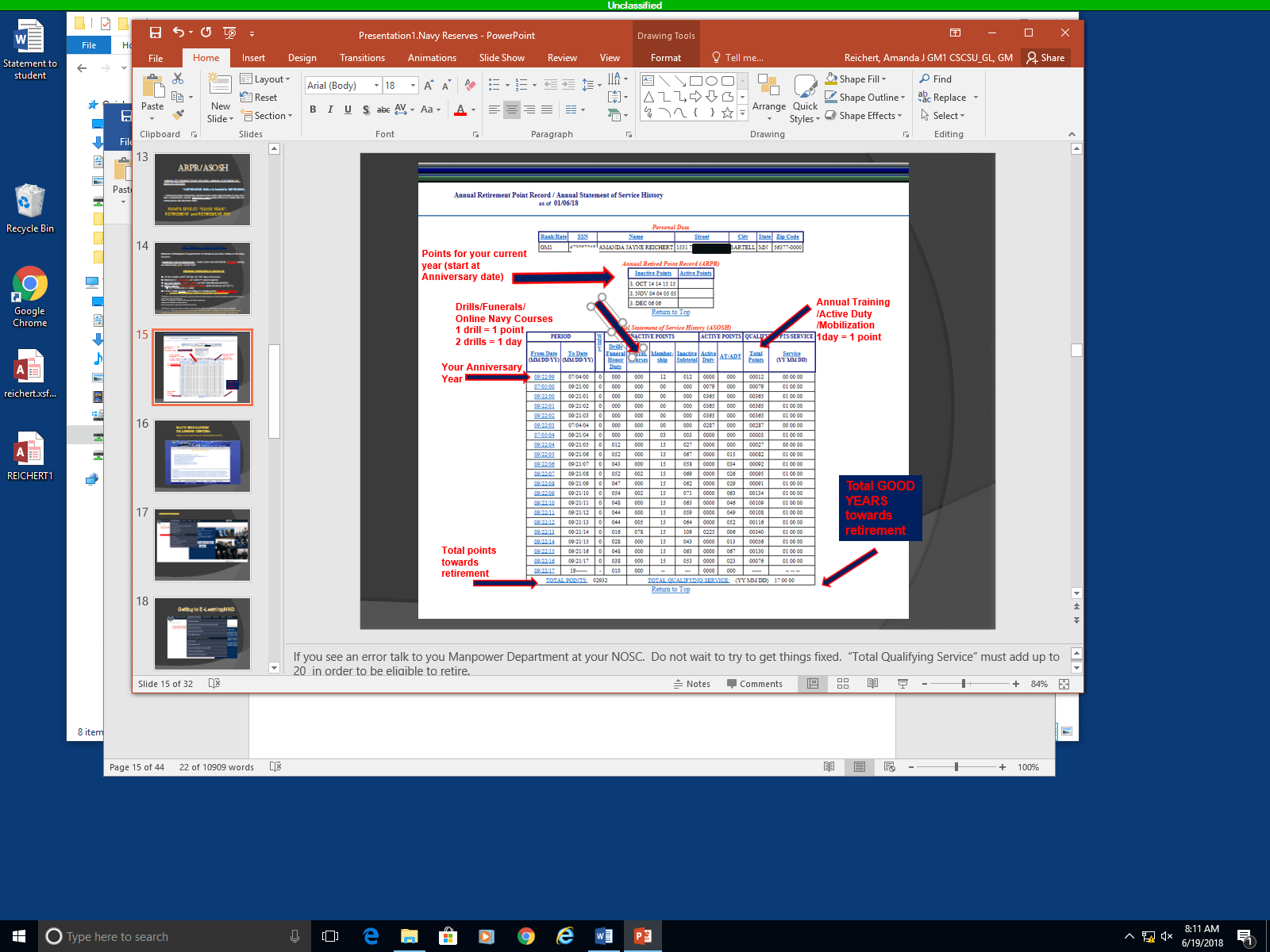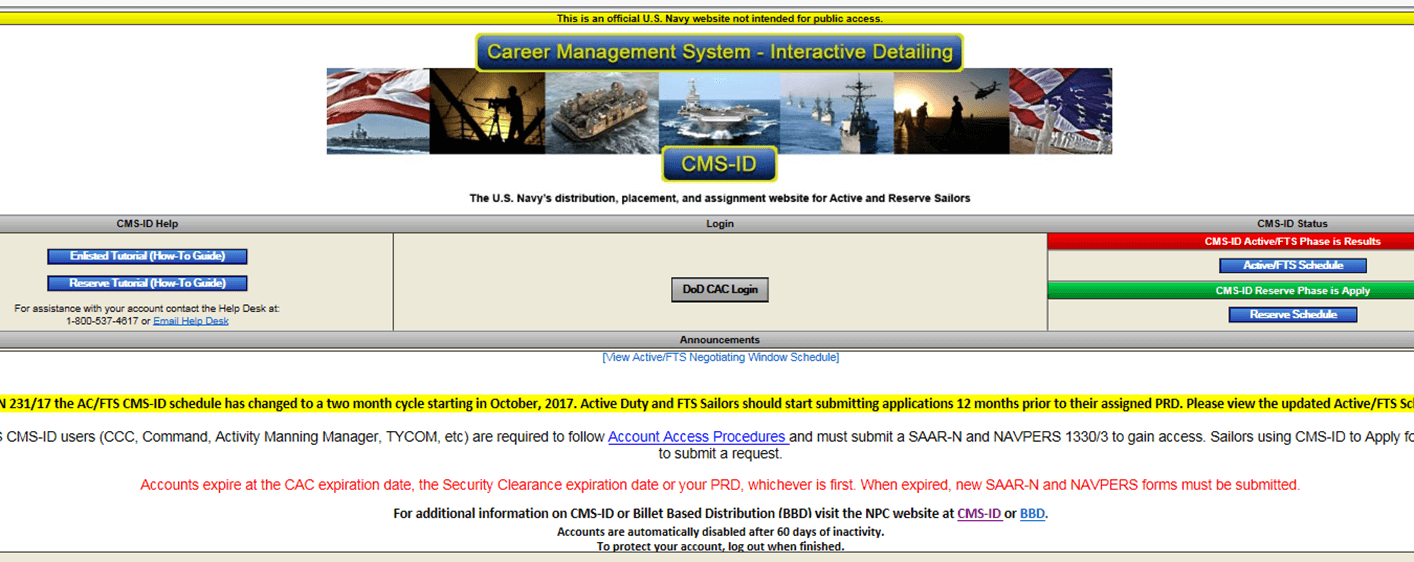Manpower
Office Code N1
The Manpower department manages unit manning, and processes muster sheets, reserve points, and drill pay issues. As a reservist, you are responsible for reading, understanding, and complying with BUPERSINST 1001.39 series, administrative procedures for navy reservists, available at BUPERS Instructions at http://www.public.navy.mil/bupers-npc/reference/instructions/BUPERSInstructions/Pages/default.aspx and with the navy reserve Personnel Manual available at RESPERS M-1001.5 at: https://private.navyreserve.navy.mil/cnrfc/N-Codes/N1/CNRFC_N1C2/SitePages/Home.aspx. The following highlights of information from those instructions along with some NOSC specific information.
ELECTRONIC SERVICE RECORD (ESR)
The ESR replaced the paper service record as the single field-level data entry point for service record maintenance. The ESR provides individual Sailors, Personnel Support Detachments (PSDs), Navy Operational Support Centers (NOSC’s); with secure worldwide Internet access to personnel, training and awards data. To view your ESR navigate to the website https://nsipsprod.nmci.navy.mil/nsipsclo/jsp/index.jsp. Under System Access Authorization Request (SAAR), click on New Users ESR Self-Service and follow the appropriate instructions. See training and awards data. To view your ESR navigate to the website Under System Access Authorization Request (SAAR), click on New Users ESR Self-Service and follow the appropriate instructions. See instructions listed in NAVADMIN 292/06 for additional information. Your ESR contains data such as:
- Member Data Summary – Personal, career and command information about you.
- Dependency Data – Information found in the Service Record Page 2 (NAVPERS 1070-602), Record of Dependency Application and Emergency Data - review frequently.
- SGLI– Amount and Election Date of your Servicemen’s Group Life Insurance (SGLI) coverage - keep beneficiaries updated!
- History of Assignments – Record of Duty assignments.
- Training Summary – Civilian, Military, and off-duty Education and Personal Qualifications Standards (PQS).
- Montgomery GI Bill (MGIB) – Current status of Active Duty MGIB and MGIB Selected Reserve.
- Honors and Awards – List of all Awards and Honors received by the member.
- Fitness Report – All Performance Evaluations and Fitness Reports (E-5 and above) recorded in NSIPS.
NAVY RESERVIST STATUS
Each member of the Navy Reserve who is not on the Active Duty List (ADL) is placed in one of three categories: 1. Ready Reserve (USNR-R); 2. Standby Reserve, consisting of the Standby Reserve-Active (USNR-S1) and Standby Reserve-Inactive (USNR-S2); 3. Retired Reserve (USNR-Retired). Members in the USNR-R and USNR-S1 are considered to be in an active status; members in the USNR-S2 are in an inactive status; members in the USNR-Retired are in a retired status. A key difference between “active” and “inactive” reservists, is that inactive reservists cannot earn retirement points or be paid. The Ready Reserve is made up of the Selected Reserve and the Individual Ready Reserve (IRR). The Selected Reserve are those who are paid to drill as members of units, while those in the IRR either drill for no pay in the Voluntary Training Unit (VTU) or are assigned to the Active Status Pool (ASP).
MINIMUM PARTICIPATION REQUIREMENTS
There are a lot of different participation requirements to stay in the reserves. In order to stay an active reservist (and eligible to earn retirement points), a member must earn at least 27 points in his or her anniversary year. In order to stay in the selective reserve or VTU, a reservist must satisfactorily attend 40 of 48 scheduled Inactive Duty Training (IDT) periods in a progressive 12-month period. SELRES must perform a minimum of 12-14 days Annual Training (AT), or equivalent Active Duty Training (ADT) as stipulated by the annual COMNAVRESFORNOTE 1001, within each fiscal year. AT waivers may be granted by the NOSC CO, but only for good reasons such as Mobilization or medical issues that prevent going on AT. Drilling reservists must report for scheduled physical examination(s) and provide medical information and documentation as requested to determine physical qualification for retention in the Navy Reserve. Members must report any factor(s) that could jeopardize their mobilization potential and must comply with involuntary recall to Active Duty.
HOW TO EARN POINTS
Reservists earn one retirement point for each day of active duty, whether Annual Training (AT), Active Duty for Training (ADT), Active Duty for Special Work (ADSW), or mobilization (MOB), including travel time. Reservists also earn one point per IDT period, and 15 points per year simply for participating in the active reserves.
INACTIVE DUTY FOR TRAINING (IDT): DRILLS, “FLEX” and “RESKEDS”
Enhancement for Drill Management (EDM) is an automated Navy Reserve drill management function in NSIPS. This NSIPS function is to be used when individual Sailors want to request reschedule or additional drills. Requests must be submitted five days in advance to allow the unit and NOSC enough time to review requested drills. When EDM requests are approved or disapproved, member will get notification to the email address in their profile. Members must be mustered by an E6 or above on the actual date of approved drills and ensure detailed tasks and accomplishments are submitted. Failure to muster within three days of the drill will result in unexcused absences.
RESKED DRILLS


IDT periods, also known as “drills,” are typically performed on your unit’s scheduled IDT weekend each month. One paid IDT period is four hours and one non-paid IDT period is two hours. A typical drill weekend consists of four IDT periods (2 on Saturday, 2 on Sunday), which adds up to 48 IDT’s per year. Your unit will muster you and the Manpower department will process the muster sheet for points and pay. View the NOSC sharepoint site for IDT schedule details.
Drills that are missed without advance authorization are “unexcused”. Unexcused absences can also lead to separation from the reserves (see minimum participation rules above). Unit Commanding Officers may authorize in advance for their members to reschedule drills to another day (“resked”) or another location (“flex”), or authorize their absence. Follow your unit’s process for routing requests through your unit CO to the NOSC, and be sure to include the reasons for rescheduling. Reasons for rescheduling must be for Navy rather than personal reasons. The Unit CO may also authorize his members to perform IDT’s at a location other than a military facility, but those members must sign a Page 13 entry prior to performing flex or telecommuting IDT’s. Members wishing to telecommute must also complete a telework package. When scheduling, keep in mind that no more than two IDT periods may be performed in a 24-hour period.
Additional Training Periods (ATP) are additional paid IDT periods for specific units/billets to support a unit's specified mobilization mission. Readiness Management Periods (RMP) are additional paid IDT used to support day-to-day unit operation and accomplish unit admin, training preparation, support activities, and maintenance functions. RMP cannot be performed on the same day as any other IDT and only one RMP may be credited per day. Your unit CO may also authorize Non-Paid IDT. Non-paid IDT periods will be at least two hours in length and one retirement point for each IDT period performed.
CORRESPONDENCE COURSES
https://www.courses.netc.navy.mil/ Effective 1 October 2014 Commander, Navy Personnel Command (COMNAVPERSCOM) ceased automated crediting of retirement points for completed correspondence courses. Sailors must receive approval to receive non-pay retirement point credit for courses listed on Assistant Secretary of the Navy (ASN) approved list. Prior to enrolling in a correspondence course, member must have an approved special request chit signed by unit chain of command and a Page 13. One Non-Pay point is awarded per four hours of authorized instruction. Correspondence course retirement points cannot be awarded while on Inactive Duty Training (IDT), Funeral Honors Duty (FHD), or active duty such as AT, ADT, ADSW, or mobilization.
BEWARE THE POINT PITFALLS!
The FY and anniversary year requirements, coupled with IDT reschedules, can get you in trouble. Every drilling reservist is authorized 48 drills per FY, but they cannot be rescheduled across fiscal years. If you reschedule your drills to September and then cannot perform them- they are lost! Also, when drills are rescheduled, retirement points are credited the days the duty is actually performed and entered to the anniversary year accordingly. Correspondence Courses are recorded in the anniversary year based on the completion date assigned on the completion letter. Make sure that you actually perform enough IDT, AT, or courses to reach 50 points or that year will not qualify.
No more than 130 points per anniversary year can be credited from drills, correspondence courses and membership in the Navy Reserve Component.

RUAD MANAGEMENT
As a drilling reservist, you will be a member of a unit. The Reserve Unit Assignment Document (RUAD) is the official manning document and manpower authorization for Selected Reserve units. RUADs contain specific billet requirements for paygrade, designator/rating, and required Naval Officer Billet Classification (NOBC)/Navy Enlisted Classification (NEC) codes. Since exact paygrade, designator/rating, or NOBC/NEC matches are not always possible, RUADs list Reserve Functional Area and Sex (RFAS) codes which identify allowable substitutions. A unit’s current RUAD shows who are assigned to an authorized billet, those who are cross assigned, and those who are assigned to a unit in an In Assignment Processing (IAP) status. The RUAD also contains IMS/MAS codes, PRD/NEC information, and mobilization data for each individual on the RUAD.
BILLET – CMS-ID

Generally, recruiters find the initial billets for new SELRES accessions. Except for a few managed communities, members are responsible for applying for their subsequent billets as they progress through their careers. Officers are required to apply for orders through the APPLY board or the JO-APPLY system. The APPLY website is linked from the Applications menu on the Navy Reserve Homeport website at https://private.navyreserve.navy.mil/Pages/default.aspx.
Enlisted personnel are required to utilize Career Management System (CMS/ID) in order to negotiate for orders. https://www.cmsid.navy.mil. To apply for a billet or transfer to a new unit please follow the link below to initiate the application process.
- https://www.cmsid.navy.mil. When searching for a billet, select the “JOB” tab.
- Search Criteria: Enter Rate, Paygrade & scroll to the bottom right & select the region you are interested in. Then click “SEARCH”.
- If there are any available billets open for application, they will be listed on the bottom of the page once it refreshes.
- If you see one you are interested in, click on the “BILLET TITLE” and this will bring you to a new screen with all the information in regards to that particular job. If you would like to apply, scroll to the bottom of the screen and click “PROCEED TO APPLICATION”.
- Once you have completed the application, make sure you place comments in the ‘Sailor Comment Block.’ The more information you provide to the Enlisted Coordinator the better.
NOTE: If you want to drill at the NOSC closest to your home of residence, please make sure to note this in your comments block, it’s important that the Enlisted Coordinator knows this)
TRANSFERS
Involuntary transfers may occur due to a vacancy in a priority unit or any vacancy for a member who is not assigned a local billet. Failure to accept an involuntary transfer to a priority unit will normally result in termination from Selected Reserve Status and transfer to the Individual Ready Reserve (IRR). Transfers between centers must be handled within 30 days to avoid receiving unsatisfactory or adjudicated drills.
IRR Transfer
Transfer to the IRR may be initiated by the member through the unit chain of command, approved by NOSC CO or CNRFC via RCC if there is a drilling obligation. If you request transfer to the IRR and still have a military obligation remaining, you remain subject to potential mobilization and may be denied transfer until obligation is satisfied.
High Year Tenure (HYT) Transfer
Once a member reaches HYT, a transfer to the Voluntary Training Unit (VTU) or IRR will be initiated.
SUB-ASSIGNMENT / ADDU (ADDITONAL DUTY)
Members who want to drill at another unit without a permanent transfer must receive prior approval from their unit CO and the unit CO for the unit where they wish to drill. Members should complete a request to be subassigned to both units for their approval. Once complete, the unit that the member belongs to (as per the RUAD) shall submit the approved subassigned form to NOSC Manpower to approve the subassignment. Once this subassigned form of approval has been forwarded, Manpower will initiate ADDU orders which authorize the CO of the unit to which the member is being subassigned, (and by direction members) to approve the member’s drills. Manpower will notify RESPAY. The original unit the member belongs to will still be responsible and held accountable for all readiness for the member. Note that even though a member is subassigned, the member will still be on the RUAD with the original unit and will still show up on the muster sheet for the original unit. The unit the member is now subassigned with will need to utilize form 1570/22 to document drills that have been completed.
CROSS-ASSIGNED
Cross assignment allows members to drill close to home while filling a paid billet in a unit at another NOSC. Members that are cross-assigned will be on two RUAD’s. A cross-assigned (CA) sailor is both cross-assigned out (CAO) to their local Training Reserve Unit Identification Code (TRUIC) unit, and cross-assigned in (CAI) to the Unit Mobilization Unit Identification Code (UMUIC) unit where the mobilization billet they are filling resides. The member is responsible for all readiness matters to the local unit to which they are they are CAO, but will do all ATs with the unit to which they are CAI. A member can do AT elsewhere, but it will need to be coordinated with and approved by the unit. Personnel are authorized to apply for local vacant billets in CMS-ID or JOAPPLY prior to expiration of PRD.
IN-ASSIGNMENT PROCESSING
Sometimes members don’t have a billet available at a local NOSC, so they are temporarily given a position referred to as In Assignment Processing (IAP). Temporary assignment to paid IAP will be for 90 days to allow personnel to search via CMSID, JO APPLY and APPLY and compete for a billet. Personnel IAP over 90 days will be subject to assignment orders initiated by COMNAVRESFORCOM (N12). Personnel IAP over 120 days will be subject to transfer to the VTU in a Non-Pay status in accordance with directive manning.